
Biological control or biocontrol is a method of controlling pests, such as insects, mites, weeds, and plant diseases, using other organisms. It relies on predation, parasitism, herbivory, or other natural mechanisms, but typically also involves an active human management role. It can be an important component of integrated pest management (IPM) programs.

The parsnip is a root vegetable closely related to carrot and parsley, all belonging to the flowering plant family Apiaceae. It is a biennial plant usually grown as an annual. Its long taproot has cream-colored skin and flesh, and, left in the ground to mature, it becomes sweeter in flavor after winter frosts. In its first growing season, the plant has a rosette of pinnate, mid-green leaves. If unharvested, it produces a flowering stem topped by an umbel of small yellow flowers in its second growing season, later producing pale brown, flat, winged seeds. By this time, the stem has become woody, and the tap root inedible.

Forficula auricularia, the common earwig or European earwig, is an omnivorous insect in the family Forficulidae. The European earwig survives in a variety of environments and is a common household insect in North America. The name earwig comes from the appearance of the hindwings, which are unique and distinctive among insects, and resemble a human ear when unfolded; the species name of the common earwig, auricularia, is a specific reference to this feature. They are considered a household pest because of their tendency to invade crevices in homes and consume pantry foods, and may act either as a pest or as a beneficial species depending on the circumstances.
Northern root-knot nematode is a species of vegetable pathogens which produces tiny galls on around 550 crop and weed species. They invade root tissue after birth. Females are able to lay up to 1,000 eggs at a time in a large egg mass. By surviving harsh winters, they can survive in cold climates.
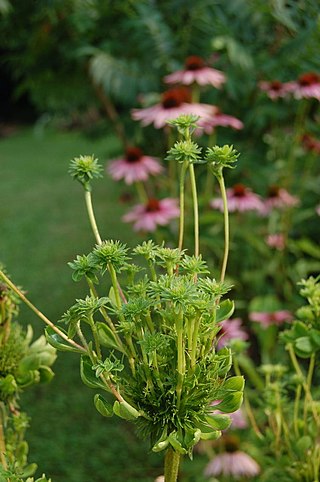
Phytoplasmas are obligate intracellular parasites of plant phloem tissue and of the insect vectors that are involved in their plant-to-plant transmission. Phytoplasmas were discovered in 1967 by Japanese scientists who termed them mycoplasma-like organisms. Since their discovery, phytoplasmas have resisted all attempts at in vitro culture in any cell-free medium; routine cultivation in an artificial medium thus remains a major challenge. Phytoplasmas are characterized by the lack of a cell wall, a pleiomorphic or filamentous shape, a diameter normally less than 1 μm, and a very small genome.

Aster yellows is a chronic, systemic plant disease caused by several bacteria called phytoplasma. The aster yellows phytoplasma (AYP) affects 300 species in 38 families of broad-leaf herbaceous plants, primarily in the aster family, as well as important cereal crops such as wheat and barley. Symptoms are variable and can include phyllody, virescence, chlorosis, stunting, and sterility of flowers. The aster leafhopper vector, Macrosteles quadrilineatus, moves the aster yellows phytoplasma from plant to plant. Its economic burden is primarily felt in the carrot crop industry, as well as the nursery industry. No cure is known for plants infected with aster yellows. Infected plants should be removed immediately to limit the continued spread of the phytoplasma to other susceptible plants. However, in agricultural settings such as carrot fields, some application of chemical insecticides has proven to minimize the rate of infection by killing the vector.

Alternaria is a genus of Deuteromycetes fungi. All species are known as major plant pathogens. They are also common allergens in humans, growing indoors and causing hay fever or hypersensitivity reactions that sometimes lead to asthma. They are present in the human mycobiome and readily cause opportunistic infections in immunocompromised people such as AIDS patients.

Curly top is a viral disease that affects many crops. This disease causes plants to become smaller in size, have shriveled petals and leaves, and are twisted and pulled out of shape. They are often caused by curtoviruses, members of the virus family Geminiviridae. This disease is important in western United States, such as California, Utah, Washington, and Idaho.
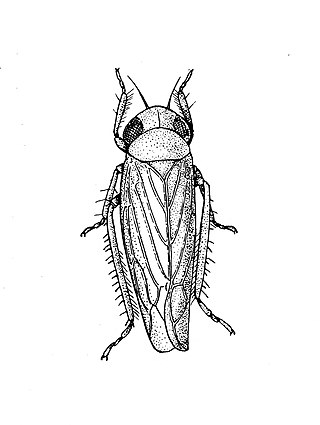
The beet leafhopper, also sometimes known as Neoaliturus tenellus, is a species of leafhopper which belongs to the family Cicadellidae in the order Hemiptera.

Ditylenchus dipsaci is a plant pathogenic nematode that primarily infects onion and garlic. It is commonly known as the stem nematode, the stem and bulb eelworm, or onion bloat. Symptoms of infection include stunted growth, discoloration of bulbs, and swollen stems. D. dipsaci is a migratory endoparasite that has a five-stage lifecycle and the ability to enter into a dormancy stage. D. dipsaci enters through stomata or plant wounds and creates galls or malformations in plant growth. This allows for the entrance of secondary pathogens such as fungi and bacteria. Management of disease is maintained through seed sanitation, heat treatment, crop rotation, and fumigation of fields. D. dipsaci is economically detrimental because infected crops are unmarketable.
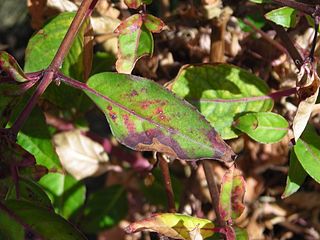
Impatiens necrotic spot orthotospovirus(INSV) is a plant pathogenic virus of the order Bunyavirales. It was originally believed to be another strain of Tomato spotted wilt virus, but genetic investigations revealed them to be separate viruses. It is a negative-strand RNA virus which has a tripartite genome. It is largely spread by the insect vector of the western flower thrips. The virus infects more than 648 species of plants including important horticultural and agricultural species such as fuchsia, tomato, orchids, and lettuce. As the name implies, the main symptom on plants is necrotic spots that appear on the leaves. The INSV virus infects by injecting the RNA the virus contains into the cell which then starts using the cell resources to transcribe what the virus RNA states. Viral infection can often result in the death of the plant. The disease is mainly controlled by the elimination of the western flower thrip vector and by destroying any infected plant material.

Graphocephala coccinea is a meadow and woodland-dwelling species of brightly colored leafhopper native to North and Central America, from Canada south to Panama. Common names include candy-striped leafhopper, red-banded leafhopper, scarlet-and-green leafhopper and red-and-blue leafhopper.

Bacterial soft rots are caused by several types of bacteria, but most commonly by species of gram-negative bacteria, Erwinia, Pectobacterium, and Pseudomonas. It is a destructive disease of fruits, vegetables, and ornamentals found worldwide, and affects genera from nearly all the plant families. The bacteria mainly attack the fleshy storage organs of their hosts, but they also affect succulent buds, stems, and petiole tissues. With the aid of special enzymes, the plant is turned into a liquidy mush in order for the bacteria to consume the plant cell's nutrients. Disease spread can be caused by simple physical interaction between infected and healthy tissues during storage or transit. The disease can also be spread by insects. Control of the disease is not always very effective, but sanitary practices in production, storing, and processing are something that can be done in order to slow the spread of the disease and protect yields.

Macrosiphum euphorbiae, the potato aphid, is a sap-sucking pest insect in the family Aphididae. It infests potatoes and a number of other commercially important crops.
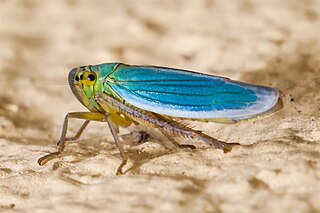
Cicadella viridis, the green leafhopper, is a species belonging to the subfamily Cicadellinae of the family Cicadellidae.
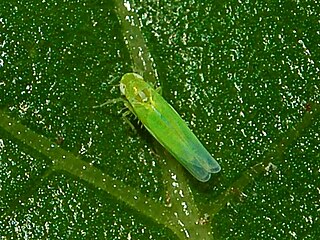
Empoasca decipiens is a species of leafhopper belonging to the family Cicadellidae subfamily Typhlocybinae. The adults reach 3–4 millimetres (0.12–0.16 in) of length and a are homogenously green with whitish markings on its pronotum and vertex. E. decipiens is commonly referred to as the “green leafhopper” because of its colouration. The absence of clear stripes along the forewings can easily distinguish it from the similar leafhopper species E. vitis, but distinguishing it from other leafhoppers with the same colouration requires examination under a microscope. It is present in most of Europe, in the eastern Palearctic realm, in North Africa, in the Near East, and in the Afrotropical realm. Both nymphs and adults of this small insect are considered to be a very destructive pests on field crops, vegetables and greenhouse plants.

Claude W. Fuller graduated from Australia's Melbourne University. He worked as an entomologist in Australia but worked more extensively in South and Southern Africa.
Jacobus van der Vecht, nicknamed Jaap, was a Dutch entomologist who specialised in Hymenoptera, especially those of the East Indies and New Guinea.
Listronotus oregonensis, the carrot weevil, is a species of weevil in the beetle family Curculionidae. It is found in North America.
Milkweed yellows phytoplasma is a strain of phytoplasma in the class Mollicutes, a class of bacteria distinguished by the absence of a cell wall. The phytoplasma strain is denoted by the acronym MW1.
















